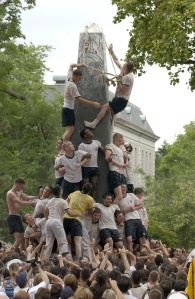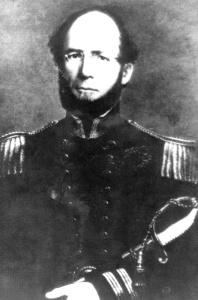Commander William Lewis Herndon (25 October 1813 – 12 September 1857) was one of the United States Navy's outstanding explorers and seamen. He chose to go down with his ship while other lives were still aboard and while in command of the steamer Central America's 44th trip, which sank in a three day and night hurricane off Cape Hatteras, North Carolina. His daughter Ellen Lewis Herndon Arthur was the wife of future U.S. President Chester A. Arthur.
William Lewis Herndon was born in Fredericksburg, Virginia. Herndon was appointed Midshipman on November 1, 1828. He cruised in Pacific, South American, Mediterranean, and Gulf waters from then until 1842.
From 1842 to 1846 Herndon served in the Depot of Charts and Instruments (later to become the United States Naval Observatory) with his brother-in-law, Matthew Fontaine Maury, preparing oceanographic charts and performing other scientific work invaluable to the safe and accurate navigation of the seas.
During the Mexican-American War, Herndon commanded the brig Iris with distinction.
In 1851 Herndon headed an expedition exploring the Valley of the Amazon, a vast uncharted area. Departing Lima, Peru, 21 May 1851, Herndon and his small party of six men pressed into the wild and treacherously beautiful jungles. After a remarkable journey of 4,366 dangerous miles, which took him through wilderness from sea level to heights of 16,199 feet, Herndon reached the city of Pará, Brazil on 11 April 1852. On 26 January 1853 Herndon submitted an encyclopedic and profusely illustrated 414-page report to the Secretary of the Navy John P. Kennedy. The report was later published as Exploration of the Valley of the Amazon published 1853.
This volume was unusual and of such importance that in an unusual move, it was immediately ordered, "10,000 additional copies be printed for the use of the Senate."
After two years of active service in Potomac and San Jacinto, Herndon, now a commander, was given leave in 1855 to command the Atlantic Mail Steamship Company steamer SS Central America, 20 June 1857, on the New York to Aspinwall run. (Central America had recently been renamed from George Law. Aspinwall was an Anglo-alternative name for Colón, Panama.)
Making his way up the coast from Aspinwall with perhaps 15 tons of gold (then worth $2,000,000) and 474 passengers, as well as 101 crew members, Herndon encountered a three-day hurricane off Cape Hatteras on 7 September 1857. The hurricane steadily increased in savagery until the 12th, and Central America was shipping water through several leaks. As the ship pitched and rolled through the pounding seas, water in her hold put out her boiler fires.
Commander Herndon reluctantly admitted that, despite the valiant efforts of crew and passengers alike, his ship was doomed and summoned aid by firing the ship's minute guns. At 2 p.m., West Indian brig Marine arrived to aid the stricken steamer. Disregarding his own life, Commander Herndon supervised the loading of women and children into lifeboats and watched them pull to safety in Marine. Herndon's bravery and his concern for his passengers and crew helped save 152 of the 575 people on board.
Commander William Lewis Herndon was last seen in full uniform, standing by the wheelhouse with his hand on the rail, hat off and in his hand and bowed in prayer as the ship gave a lurch and went down. The loss of so much gold contributed in part to the Panic of 1857.
Herndon's memory has been honored in various ways:
* A monument at the United States Naval Academy in Annapolis, Maryland commemorates this intrepid explorer and gallant seaman.
* The Navy has named two destroyers USS Herndon in his honor:
http://en.wikipedia.org/wiki/USS_Herndon_%28DD-198%29 http://en.wikipedia.org/wiki/USS_Herndon_%28DD-638%29 * The towns of Herndon, Virginia and Herndon, Pennsylvania are also named for him.


 William Lewis Herndon
William Lewis Herndon 





 - b.1649 in Marden, Maidstore, Kent, England d.1722 in Hampton Parrish, York County, Virginia
- b.1649 in Marden, Maidstore, Kent, England d.1722 in Hampton Parrish, York County, Virginia


 - b.Mar 1678 in St. Stephens Parish, New Kent County, Virginia d.09 Mar 1758 in Caroline County, Virginia
- b.Mar 1678 in St. Stephens Parish, New Kent County, Virginia d.09 Mar 1758 in Caroline County, Virginia



 - b.~ 1654 in Hampton, Elizabeth City, Virginia d.1729 in Caroline County, Virginia
- b.~ 1654 in Hampton, Elizabeth City, Virginia d.1729 in Caroline County, Virginia

 - b.1702 in King and Queen County, Virginia d.Oct 1759 in Spotsylvania County, Virginia
- b.1702 in King and Queen County, Virginia d.Oct 1759 in Spotsylvania County, Virginia







 - b.23 May 1674 in Newport, Pagnell, Buckinghamshire, England d.1727 in Caroline County, Virginia
- b.23 May 1674 in Newport, Pagnell, Buckinghamshire, England d.1727 in Caroline County, Virginia



 <Unknown>
<Unknown>
 - b.01 May 1737 in Berkeley Parish, Spotsylvania County, Virginia d.28 Oct 1810 in Fredericksburg, Virginia
- b.01 May 1737 in Berkeley Parish, Spotsylvania County, Virginia d.28 Oct 1810 in Fredericksburg, Virginia



 - b.~ 1629 in Castle Camps, Cambridge, England d. in Virginia
- b.~ 1629 in Castle Camps, Cambridge, England d. in Virginia


 - b.~ 1675 in Gloucester, Virginia d.> 1715 in Spotsylvania County, Virginia
- b.~ 1675 in Gloucester, Virginia d.> 1715 in Spotsylvania County, Virginia



 <Unknown>
<Unknown>

 - b.~ 1700 in King and Queen County, Virginia d.>04 Oct 1743 in Spotsylvania County, Virginia
- b.~ 1700 in King and Queen County, Virginia d.>04 Oct 1743 in Spotsylvania County, Virginia







 - b.~ 1676 in Virginia d.1715
- b.~ 1676 in Virginia d.1715 - b.14 Apr 1783 in Berkeley Parish, Spotsylvania County, Virginia d.20 Dec 1824 in Fredericksburg, Virginia
- b.14 Apr 1783 in Berkeley Parish, Spotsylvania County, Virginia d.20 Dec 1824 in Fredericksburg, Virginia
 - b.07 Mar 1741 in Caroline County, Virginia d.26 Oct 1822 in Spotsylvania County, Virginia
- b.07 Mar 1741 in Caroline County, Virginia d.26 Oct 1822 in Spotsylvania County, Virginia
 - b.12 Jan 1789
- b.12 Jan 1789





